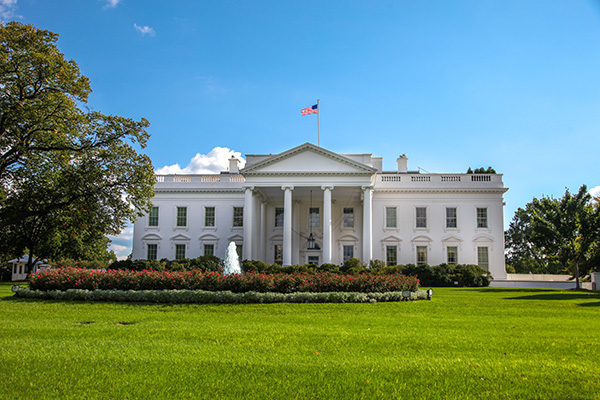Proposed fiscal 2020 White House budget allocates $21.4 billion for transportation
The budget, which was released yesterday, requested $21.4 billion in discretionary budget authority for 2020, which represents a $5.9 billion, or 22% decrease, compared to its 2019 discretionary estimate, and also provides $62.2 billion in mandatory funds and obligation limitations.
In its fiscal 2020 budget proposal, entitled a “A Budget for a Better America,” the White House gives transportation infrastructure its due, even though many freight transportation and supply chain stakeholders largely have dismissed President Trump’s inaction on transportation infrastructure, which he touted as a campaign promise, since he formally took office in January 2017.
The budget, which was released yesterday, requested $21.4 billion in discretionary budget authority for 2020, which represents a $5.9 billion, or 22% decrease, compared to its 2019 discretionary estimate, and also provides $62.2 billion in mandatory funds and obligation limitations.
In regards to surface transportation infrastructure, the White House budget said the 2020 proposal fully funds Highway Trust Fund-supported programs at levels that are consistent with the fifth and final year of the FAST (Fixing America’s Surface Transportation) Act, which former President Barack Obama signed into law in December 2015. The five-year, $305 billion FAST Act, at the time of its signing, represented the first law enacted in more than ten years that provides long-term funding certainty for surface transportation, with states and local governments able to move forward with critical transportation projects like new highways and transit times, as well as being assured they will have a long-term Federal partner, too, according to the Department of Transportation.
Looking ahead, the White House said in its budget proposal that it looks forward to working with Congress to enact a long-term successor to the FAST Act, explaining that “a long-term bill is necessary to provide certainty to America’s State, local, and private partners so they can plan and invest in projects with confidence.”
What’s more, the 2020 budget proposal includes $200 billion for additional infrastructure investments, with the White House saying it will work with Congress on allocating this funding in order to advance projects that are most beneficial for Americans.
Developing and building transportation infrastructure projects through competitive programs to generate large investment returns remains a core focus of the White House’s planning and was made clear in the budget proposal.
This is already intact through its Better Utilizing Investments to Leverage Development (BUILD) competitive grant program, which replaced its successor, the TIGER grant program, in April 2018, with the budget allocating $1 billion for BUILD. The objective of BUILD is to leverage the development competitive grant program that supports economic competitiveness and quality of life, especially in rural areas.
There is also $2 billion allocated for the Infrastructure for Rebuilding America (INFRA) competitive grant program, with a $1 billion increase over the FAST Act-authorized level. The INFRA program provides the seed money needed to boost non-Federal investment for projects that relieve congestion on the U.S. multimodal freight network.
While this budget proposal represents a 22% funding decrease from fiscal 2019 to 2020, the budget’s funding for transportation infrastructure heads up after 2020, a Washington, D.C-based supply chain stakeholder told LM.
“That is coming with the assumption that whatever [bill] replaces the FAST Act will come with a big financial bump,” he said. “It sounds like the White House expects Congress to come out with a bigger budget for infrastructure, and the White House is supportive of that.”
The White House, noted the stakeholder, is also interested in increasing the leverage of federal dollars, with the caveat being it is unclear if that would be in the form of public-private partnerships or expanding TIFIA, the Transportation Infrastructure Finance and Innovation Act (TIFIA) program which provides Federal credit assistance in the form of direct loans, loan guarantees, and standby lines of credit to finance surface transportation projects of national and regional significance, or doing more federal guarantees of state and local bond money.
“They are figuring that their cutback is going to be offset by leveraging these things in different ways,” he said. “It is a different signal. And there continues to be a real focus on the way in which the U.S. modernizes and streamlining the way projects are delivered.”
Another strong signal in this budget proposal came in the form of the mission of the Department of Transportation, which still maintains that it strives to ensure the U.S. has the safest, most efficient, and modern transportation system in the world, and improves quality of life, but it also says it is focused on improving the productivity and competiveness of American workers and businesses, which was not previously included.
This sets the stage for the competitive, or ROI, component of project awards, which the stakeholder viewed as very important.
“It is not just giving money because you have to, and it goes to who shouts the loudest, which has been the case in the past, as well as political grants, too,” he said, “but this sends the signal that efficiency and ROI are key. There is not an unlimited budget so the available money will go where it makes the most difference.”
As for prospects of a FAST Act replacement coming in 2020, there is growing sentiment that if the House or Senate have not passed an infrastructure bill by the August recess, that a new long-term bill will not come until after the next Presidential election.













